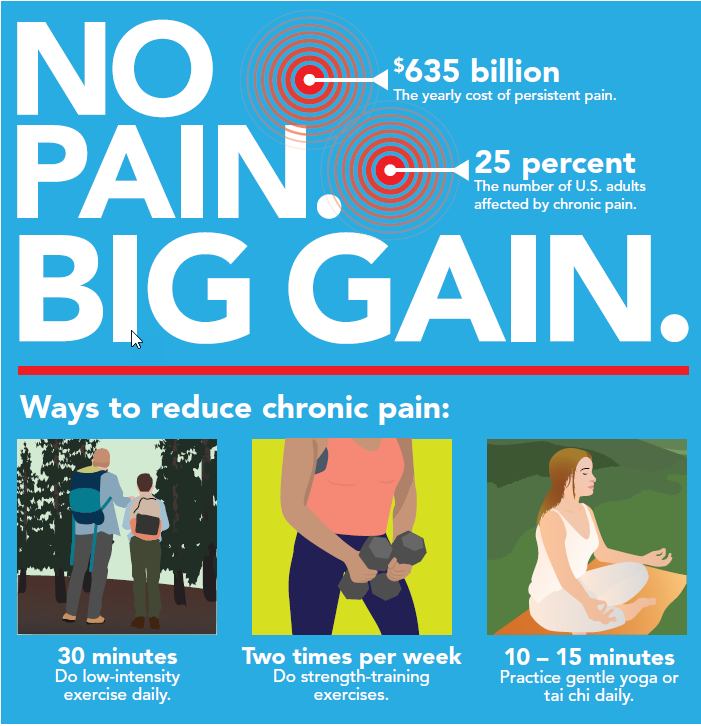Live Well
No Pain Big Gain

Reducing chronic pain can get you back to the important things in life.
If you’re living with chronic pain, it probably affects your daily activities. By arming yourself with information about the best ways to deal with your pain, you can still lead a rich, full life. There are many options and resources available.
Unlike acute pain, which is caused by an injury and disappears after the healing process is complete, chronic pain lasts more than three months. It can be a constant condition, or it might come and go for no clear reason. It’s common, affecting about 25 percent of adults in the United States.
Back Pain
About 8 percent of all American adults deal with chronic back pain. It’s the sixth most expensive medical condition in the U.S., with an annual price tag of more than $12 billion in direct and indirect costs.
To prevent back injury, experts say you should:
- Maintain good posture when standing or sitting.
- Include stretching and strength training in your workout at least two days a week.
- Practice safe lifting techniques. Bend your knees and keep your back straight.
- Maintain a healthy weight through diet and exercise.
Orthopedic Pain
Orthopedic medicine relates to the care of the musculoskeletal system, which includes bones, joints, muscles, ligaments and tendons. A variety of conditions can cause chronic orthopedic pain, including:
- Arthritis.
- Osteoporosis.
- Past injuries.
- Chronic joint pain.
- Nerve damage.
If you’re dealing with chronic orthopedic pain, your doctor can suggest treatment options for you. Depending on your circumstances, your doctor might suggest pain medication or physical therapy. Serious cases may require surgery.
Joint Pain
Many people deal with joint pain, which commonly affects the knees, hips, spine, feet or hands. It can stem from a wide variety of causes, such as injury, overuse, age or weight. Chronic conditions can also cause joint pain. They include:
- Osteoarthritis.
- Rheumatoid arthritis.
- Gout.
- Bursitis.
At-home remedies, such as exercise, over-the-counter pain medications, heating pads or ice packs, can improve joint pain. Talk to your primary care physician if chronic joint pain is affecting your daily activities. Your doctor might recommend stronger measures, including physical therapy, steroids or surgery.
Safe Opioid Use
Opioids are a category of powerful prescription pain relievers, such as oxycodone, fentanyl and tramadol. They are usually safe for treatment of acute pain when used as prescribed for short periods. For patients with chronic pain, guidelines from the Centers for Disease Control and Prevention* recommend physicians exhaust available non-opioid therapies before prescribing opioids. Doctors should prescribe opioids at the lowest possible dosage and only if the benefits are expected to outweigh the risks. The potential risks of opioids in chronic pain management include:
- Developing a tolerance. Patients taking opioids daily for extended periods might find that they need increasingly higher doses to lower their pain levels. This is a warning sign that an addiction might be forming.
- Respiratory depression. Opioid use can cause a heightened risk of slow or shallow breathing.
- Opioid use disorder. Moderate to severe opioid use disorder, also known as addiction, is a chronic brain disease caused by repeated opioid use. People with opioid addictions face a much higher risk of death from a drug overdose.
- Dependence. People who have become dependent on opioids rely on the drug to feel normal. People who stop taking opioids suddenly or lower their dosage too quickly might face a higher risk of dependence.
Have an in-depth conversation with your doctor about opioids for chronic pain. Make sure you understand how to take your medications safely, and learn about the possible side effects and risks associated with these strong drugs.
Take Back Day
The misuse of prescription drugs, including opioids, has caused a public health crisis in the United States. That’s why the U.S. Drug Enforcement Administration (DEA)* launched its National Prescription Drug Take Back Day. This event encourages people to safely dispose of unneeded prescription medications to prevent them from falling into the wrong hands. Visit www.dea.gov/takebackday** to find a collection site where you can safely and conveniently drop off your unwanted medications.
*The Centers for Disease Control and Prevention and the DEA are independent organizations that offer health information you may find helpful.
**This links to a third-party website. The DEA is solely responsible for the contents and privacy policy on its site.
***Statistics and information are accurate as of the time of publication and may change over time.
